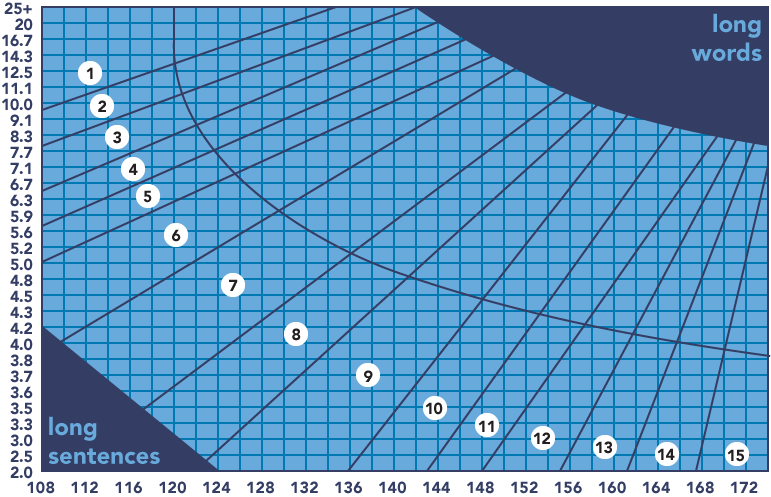Striving to maintain a moderate reading level helps writers be clearer and reach a broader audience
As I started talking to people about the concept of readability, I found that many people did not know what I was talking about. First, they were unsure what the word readability referred to. Then, they were not clear on where the different scores such as Flesch-Kincaid or SMOG came from or what the names meant. So, let?s talk about readability.
Readability score for this article: 11th grade.

Background
As an ongoing personal project, I?m developing a writing readability calculator. You can find that project at CalculateYourWords.com. It calculates word count, related metrics, and average readability score. It also lists frequently used words in your text that are less common.
What is readability?
Readability scoring approximates how many years of schooling someone needs in order to be able to understand your writing. It is used, for example, by government organizations to ensure that official texts meet a minimum readability requirement. The Texas Department of Insurance has a requirement that all insurance policy documents have a Flesch Reading Ease score of 40 or higher. This translates to the reading level of a first-year undergraduate student.
Of the many definitions of readability, my personal favorite is the 1949 definition by Dale and Chall as laid out in their ?Concept of readability.?
The sum total (including all the interactions) of all those elements within a given piece of printed material that affect the success a group of readers have [sic] with it. The success is the extent to which they understand it, read it at an optimal speed, and find it interesting.
How do we measure readability?
In its broadest sense, readability encompasses a number of factors, including many that are not easily processed by formulas. Elements such as cultural references, voice, and word choice can have a strong impact on the ?success? of different groups reading a text. Editors are the people who are most often concerned with these more subjective or abstract measurements of readability.
It?s not easy to measure readability, in the broadest sense, using technology alone. In Dale and Chall?s 1948 paper ?A formula for predicting readability,? they defined a formula which used a list of common words. When a text contained a high percentage of words that were not in that list, it was considered less easily readable.
Since that paper was published, researchers have developed many formulas to estimate readability. Humphreys and Humphreys (2013) explains that:
Over 30 years of research on more than 200 readability formulas has demonstrated moderate to strong predictive correlations with reading comprehension. These have been generally found to correlate highly with the actual readability of a text, but they may not be accurate in all cases.
Most readability formulas calculate a score that estimates the grade level or years of education of a reader. The calculations typically measure the number of long words, the number of uncommon words, sentence length, or word length. One or two of those factors will then be compared to either the total number of words or total number of sentences to generate a score.
Scores from readability formulas generally correlate highly with the actual readability of a text.
What does a readability score tell us?
Readability scores are approximations. They?re not qualitative judgements. The formulas don?t account for grammar, spelling, voice, or any other qualitative aspects of a text. A text riddled with grammatical issues might receive the same readability score as one with perfect grammar.
The primary takeaway from the common formulas is simple. Using shorter sentences with shorter, more common words will typically make a piece of writing easier to understand.
What do the names of the scoring systems mean?
For the most part, the different names of the scoring systems are simply the names of the people who created that formula. Examples of formulas with this kind of name are:
- Flesch reading ease score
- Flesch-Kincaid grade level
- Fry graph readability formula
- Gunning fog index
- Coleman Liau grade
Some formulas do have more descriptive names. Two in particular are the Automated readability index and the SMOG level. SMOG stands for ?Simple Measure of Gobbledygook,? a tongue-in-cheek acronym created by the method?s creator, G. Harry McLaughlin.
Examples
The author of AnalyzeMyWriting.com gives Dr. Suess?s Green Eggs and Ham as an example of a book with a low average score of Grade 1.
On the other hand the same author scores ?Federalist Paper ?10″ by James Madison at 17.58. My calculator CalculateYourWords.com gave it an average score of 16. In other words, it may be difficult even for someone with an undergraduate degree (grade level 16) to read at an optimal speed and find interesting.
More insights come from the Gutenberg Readability Search, which measures the Flesch Reading Ease and Flesch-Kincaid grade levels of the public domain books in Project Gutenberg. We can use the sorting functionality to see examples of texts with low and high readability scores.
Romeo and Juliet earns a Flesch-Kincaid grade level of 3.2 ? very easy to read. Some other interesting examples of texts with a relatively low score (low scores indicating that something is easier to read) are Rostand?s Cyrano De Bergerac, Burnett?s The Secret Garden, and Wilde?s The Importance of Being Earnest.
Some examples with very high Flesch-Kincaid grade level scores are Kant?s The Critique of Pure Reason (this explains my struggle with this text as a freshman in college), Moore?s Utopia, and The Declaration of Independence.
Readability scores and intelligence
We can?t say that a low grade-level readability score makes a text objectively better. The Critique of Pure Reason is an influential and acclaimed work. Its extremely high reading level means that it will be inaccessible to many readers. However, in this case the high score is related to the complexity of Kant?s arguments. When a writer explores complex, abstract topics such as philosophy, longer sentences and less common vocabulary are necessary. For a writer to be able to express themselves, sometimes they need to write in longer sentences. A high grade-level score (low readability) often indicates that a writer has a great capacity for critical and complex thought.
So why are low grade-level scores typically considered more desirable? The answer is ?Accessibility.? A low score makes a text more accessible to all readers. The Nielson-Norman Group suggests aiming for an 8th grade reading level if your writing is meant for a broad audience.
Using shorter sentences with shorter, more common words will typically make a piece of writing easier to understand.
Writing highly complex sentences with uncommon vocabulary is a sign of the high verbal intelligence of the writer. Having a large vocabulary is a great thing. Similarly, the ability to connect concepts in complex ways is a key component of critical thinking. Using less common words and complex sentence structure is a sign of an intelligent writer. If you start testing the readability of your texts and you find you are getting very high scores, don?t despair. Improving the readability of your writing is something you can train in and improve over time. However, if we?re unaware of the concept as writers, we may be excluding many people from reading our work.
Putting complex ideas into the written word is hard. It?s even harder to do so and be understood. Writing short sentences with more common words makes for text that is easier to read. Acknowledging that writing clearly helps others understand you demonstrates high social and emotional intelligence. If you?re a writer exploring complex topics, you may struggle with clarity. I know I do. The ability to simplify writing and thus make it more accessible is a kind of intelligence in itself. I continue to strive to be a clearer writer. If you do the same, I commend you for it.
 The Fry-Graph Readability Formula ? A visual tool to determine readability grade level
The Fry-Graph Readability Formula ? A visual tool to determine readability grade level
How are readability scores calculated?
Most of the common readability formulas calculate scores based on one or a combination of the following principles:
- Shorter sentences are easier to read than longer sentences
- Shorter words are easier to read than longer words
- More common words are easier to read than less common words
The exact formulas for calculating the scores won?t be meaningful for most of my readers. However, if you are more mathematically or programming-inclined, you can visit this page that contains the exact formulas in PHP code that I developed to calculate the readability scores I use on my site. If you?re interested in this aspect, feel free to comment or reach out and I?d be happy to talk more about it.
How does readability help?
Texts that have good readability are clearer and more accessible. As an example, a legal document that is hard to read can lead to someone signing a contract without understanding what they?re agreeing to. In a less serious scenario, a reader may simply give up on a blog post part way through if it?s too difficult to read. Both situations are less than ideal. In both cases, editing for readability can improve the outcome.
Readability formulas give an approximation of the readability of a text, but one that has been shown to be quite accurate. It?s a helpful metric, in that it can identify when a writer may be using overly long sentences or too many words for their target audience. Seeking a low readability score for its own sake is pointless. It?s not in any way an objective score of the quality of a piece of writing. Instead, it can be valuable to show a writer when they may be overshooting in writing something that may go over the head of the audience. Try it ? you may be surprised by the results you get.
Thank you for reading.
P.S. The first draft of this article came out to an average grade-level score of 11.6 using WritingBoots.com. After editing, I was able to lower the grade level score to 10.9. It?s still not the easiest read, but most high school juniors (year 11) should be able to understand my points quickly and easily.
Resources
- Readability Formulas (code) ? Actual formulas in PHP code demonstrating how to calculate some of the most common readability formulas.
- Readabilty Catalog of Project Gutenberg eBooks
Readability Calculators
- CalculateYourWords.com ? A readability and word frequency calculator developed by yours truly. Under development. View the open-source codebase on GitHub.
- Free Readability Formulas ? One of the most popular readability calculators on the web.
- AnalyzeMyWriting.com ? Excellent site which provides a variety of ways to analyze text as well as explanations of readability.
Sources
- Chall, Jeanne S., and Edgar Dale. 1995. Readability revisited: the new Dale-Chall readability formula. Cambridge, Mass: Brookline Books.
- Dale, Edgar, and Jeanne S. Chall. 1948. A formula for predicting readability. [Columbus]: Bureau of Educational Research, Ohio State University.
- DuBay, W. 2004. ?The Principles of Readability?. Impact Information. https://files.eric.ed.gov/fulltext/ED490073.pdf
- Humphreys and Humphreys. 2013. ?Reading Difficulty Levels of Selected Articles in the Journal of Research in Music Education and Journal of Historical Research in Music Education?. Music Education Research International. http://www.arts.usf.edu/content/articlefiles/3985-MERI06pp15-25HumphreysHumphreys.pdf
- McLaughlin, G. H. 1969. ?SMOG Grading? a New Readability Formula?. Journal of Reading. https://ogg.osu.edu/media/documents/health_lit/WRRSMOG_Readability_Formula_G._Harry_McLaughlin__1969_.pdf
- Nielson, J. 2015. ?Legibility, Readability, and Comprehension: Making Users Read Your Words?. Nielson Norman Group. https://www.nngroup.com/articles/legibility-readability-comprehension/


